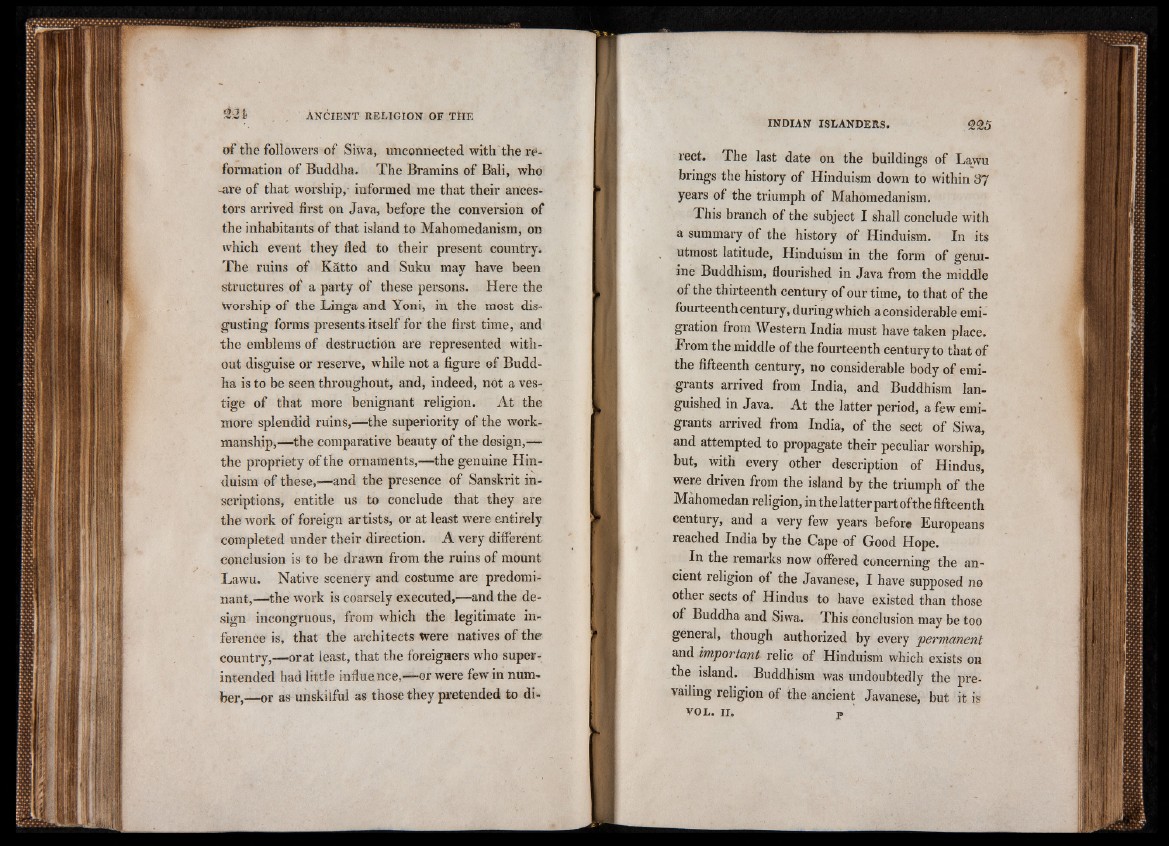
An c ie n t r e l ig io n o f Ttaoe
of the followers of Siwa, unconnected with the reformation
of Buddha. The Bramins of Bali, who
-are of that worship,- informed me that their ancestors
arrived first on Java, before the conversion of
the inhabitants of that island to Mahomedanism, on
which event they fled to their present country.
The ruins of Kâtto and Suku may have been
structures of a party of these persons. Here the
Worship of the Linga and Yoni, in the most disgusting
forms presents itself for the first time, and
the emblems of destruction are represented without
disguise or reserve, while not a figure of Buddha
is to be seen throughout, and, indeed, not a vestige
of that more benignant religion. At the
more splendid ruins,—the superiority of the workmanship,—
the comparative beauty of the design,—
the propriety of the ornaments,—the genuine Hinduism
of these,-—and the presence of Sanskrit inscriptions,
entitle us to conclude that they are
the work of foreign artists, or at least were entirely
completed under their direction. A very different
conclusion is to be drawn from the ruins of mount
Lawu. Native scenery and costume are predominant,—
the work is coarsely executed,—and the design
incongruous, from which the legitimate inference
is, that the architects Were natives of the
country,—or at least, that the foreigners who superintended
had little influence,—or were few in number,—
or as unskilful as those they pretended to direct.
The last date on the buildings of Lawu
brings the history of Hinduism down to within 37
years of the triumph of Mahomedanism.
This branch of the subject I shall conclude with
a summary of the history of Hinduism. In its
utmost latitude, Hinduism in the form of genuine
Buddhism, flourished in Java from the middle
of the thirteenth century of our time, to that of the
fourteenth century, duringwhich aconsiderable emigration
from Western India must have taken place.
From the middle of the fourteenth century to that of
the fifteenth century, no considerable body of emigrants
arrived from India, and Buddhism languished
in Java. At the latter period, a few emigrants
arrived from India, of the sect of Siwa,
and attempted to propagate their peculiar worship,
but, with every other description of Hindus,
were driven from the island by the triumph of the
Mahomedan religion, in thelatter part of the fifteenth
century, and a very few years before Europeans
reached India by the Cape of Good Hope.
In the remarks now offered concerning the ancient
religion of the Javanese, I have supposed no
other sects of Hindus to have existed than those
of Buddha and Siwa. This conclusion may be too
general, though authorized by every permanent
and important relic of Hinduism which exists on
the island. Buddhism was undoubtedly the prevailing
religion of the ancient Javanese, but it is
VOL. II. p